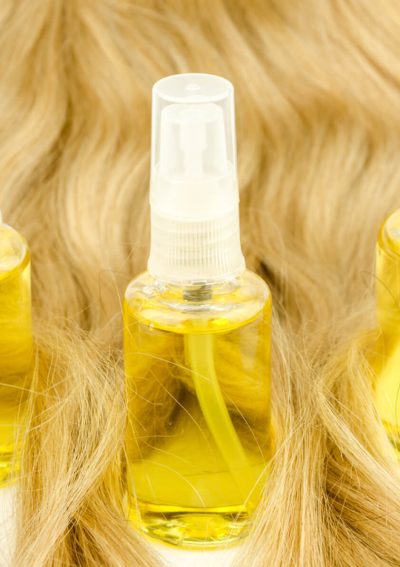Nonchemical Hair Relaxers
Using chemical hair straightening products may have adverse health effects, including a heightened risk of uterine cancer. Choosing a nonchemical hair relaxer to avoid potentially toxic exposure means weighing practical concerns against aesthetic preferences.

Why Choose Nonchemical Hair Relaxers?
Nonchemical hair straighteners could be a safer option than chemical relaxers. A study from the National Institutes of Health highlights that chemical hair straighteners have been linked to uterine cancer and other potential health concerns. Hair damage, sensitivity and cost have also led many people to look for alternatives to potentially harmful chemical hair straighteners.
The U.S. Food and Drug Administration proposed a ban on hair straightening and smoothing products containing formaldehyde in October 2023, with implementation scheduled for April 2024. However, the agency missed the original deadline.
While the FDA said banning products containing formaldehyde is a “high priority,” it missed reset deadlines in July and September. In October 2024, the agency issued a consumer fact sheet about using hair relaxers containing formaldehyde.
| Nonchemical Hair Relaxing | Chemical Hair Relaxing | |
| Application | Involves applying heat, masks, keratin or oil to your hair. | Tends to be more complex and may call for allergy tests, skin protection, even applications, precise timing and multiple stages and materials. |
| Duration of Effect | Varies in duration, but most are temporary, lasting a few days for flat-iron straightening. | Often permanent, lasting until hair grows out. |
| Effectiveness and Effects | Can instantly reduce frizz, enhance shine and create versatile hairstyles. However, excessive heat can lead to dryness, rough texture and split ends. | Using products multiple times can cause frizzy hair, dryness, hair thinning and hair loss. Hair color may become uneven, and split ends can lead to overall damage. |
| Materials | Many nonchemical hair relaxers use heat or high-quality oil. They may also include natural ingredients such as milk, honey and other food-based materials. | Various chemical straightening formulas exist, typically including a substance with a high (basic as opposed to acidic) pH. |
| Side Effects | Straightening methods like hot combs, hair dryers and flat irons can cause dehydration, protein damage and weakened hair structure, especially at high temperatures. | Chemical straighteners could cause skin damage, hair damage, kidney injury, respiratory disease and impacts on puberty and fertility. There is also a possible link between some straighteners and a higher risk for certain types of cancers, including uterine cancer. |
| Skin sensitivity | Generally, it doesn’t cause skin issues unless a person is sensitive to a specific product or ingredient. However, heat can dry out your scalp. | It could irritate sensitive skin, though chemical formulations are marketed to people with this issue. |
“Education is key in reducing the popularity of chemical relaxers,” Rachel Voss, a hairstylist and owner of Voss Salons in the Dallas area, told Consumer Notice. “In our salons, we hold workshops to inform clients about the beauty and versatility of natural hair textures, encouraging them to accept authenticity over conformity to outdated beauty standards.”
Chemical relaxers may cause harm beyond scalp and hair damage, so weighing the benefits and risks between chemical hair straighteners and nonchemical relaxers is essential.
Many people who used chemical products and experienced serious injuries are filing chemical hair straightener lawsuits. They are seeking compensation to cover medical treatments and lost wages.
Benefits of Nonchemical Hair Relaxers
Nonchemical relaxers can be gentler, easier to apply and safer than chemical alternatives. Additionally, oils and many other natural relaxers can help moisturize the scalp and hair.
Some benefits of nonchemical hair relaxers are specific to people with sensitive skin. Others might be preferable from a health perspective. For example, natural techniques don’t usually contain potentially toxic chemicals or cause possible chemical hair straightener effects like hair loss.
Chemical hair relaxers can severely impair the health of the hair follicle, according to Ghanima Abdullah, a cosmetologist and beauty consultant at therighthairstyles.com. When the hair follicle undergoes corrosion, it can’t build or hold onto healthy hair, resulting in hair loss from the follicle.
Using non-chemical hair straightening methods can help prevent weak and damaged hair that could result from chemical alternatives.
Heat, oil, silicone and keratin straightening provide straight or relaxed hairstyle options. While excessive heat treatment can also damage hair, natural products and techniques could offer more substantial benefits over chemical relaxers, which have been linked to an increased risk of cancer.
Types of Nonchemical Hair Relaxers
There are two main categories of nonchemical hair relaxing techniques, including using nonchemical products and heat treatments. These strategies may overlap. For example, someone might use a flat iron in addition to a keratin treatment.
Marketing language on product packaging or advertisements can be confusing when shopping for nonchemical hair relaxers. For example, if a manufacturer advertises the product as “lye-free,” that doesn’t necessarily mean that the product is free of other straightening chemicals.
- Heat: Flat irons pass hair between two heated plates to straighten it.
- Keratin: Chemical-free keratin is a long-lasting, professional treatment.
- Oil: People typically apply warmed oil to their hair and let it sit under a towel before washing it out.
- Silicone: Silicone is a polymer and not a natural product, but these short-term straighteners typically don’t have the same components as standard chemical relaxers.
The distinction between chemical and nonchemical relaxers isn’t always clear. Any other ingredients on a product package call for further research.
How Do Nonchemical Hair Relaxers Work?
A nonchemical hair relaxer may use oils or products like shampoos, conditioners or serums to straighten hair, allowing added freedom with styling. These products can allow for straighter hair with minimal damage or harmful chemical exposure.
Heat is another main nonchemical relaxer for natural hair. Heat treatments break hydrogen bonds, simultaneously pulling and heating hair. These bonds can form again in humid or wet conditions, causing your hair to regain its natural waves and curls.
Tips for Choosing a Nonchemical Hair Relaxer
The best nonchemical hair relaxer for you depends on your individual needs. It is more than the final look. Factors like cost, how long a treatment lasts and health concerns are also crucial to consider.
- Calculate your budget for straightening. Some techniques can be expensive at professional salons, ranging from $250 to $450.
- Determine where the natural relaxing process fits into your hygiene and beauty routine. Some techniques require more frequent applications than others.
- Set goals about your desired look. Many natural products don’t create completely flat hair.
- You can smell and feel the treated hair. Examine the look in different lights and weather. This will help you assess the best fit for you.
- Test products in small applications for skin or hair sensitivity, especially formulations with unfamiliar ingredients.
Choosing a nonchemical hair relaxer is more complicated than picking a jar on a beauty supply store’s shelf. However, finding the right solution is important if you are concerned about the potential adverse health effects of chemical products.
29 Cited Research Articles
Consumernotice.org adheres to the highest ethical standards for content production and references only credible sources of information, including government reports, interviews with experts, highly regarded nonprofit organizations, peer-reviewed journals, court records and academic organizations. You can learn more about our dedication to relevance, accuracy and transparency by reading our editorial policy.
- Needle, C.D., et al. (2024, December). Safety of Chemical Hair Relaxers: A Review Article. Retrieved from https://www.jaadreviews.org/article/S2950-1989(24)00033-3/fulltext
- U.S. Food and Drug Administration. (2024, October 15). Hair Smoothing Products That Release Formaldehyde When Heated. Retrieved from https://www.fda.gov/cosmetics/cosmetic-products/hair-smoothing-products-release-formaldehyde-when-heated
- Eldridge, D. (2024, October 14). How Do Heat Protectants for Hair Work? A Chemistry Expert Explains. Retrieved from https://theconversation.com/how-do-heat-protectants-for-hair-work-a-chemistry-expert-explains-233206
- Warner, C. (2024, August 9). CROWN Act Support Grows: 26th State Bans Hair Discrimination at Work. Retrieved from https://www.hrmorning.com/news/crown-act-hair-discrimination-at-work/
- Trichology.com (2024, August 5). The Shocking Truth About How Hairstyling Tools Damage Your Hair. Retrieved from https://www.trichology.com/the-shocking-truth-about-how-hairstyling-tools-damage-your-hair/
- San Francisco Chronicle. (2024, July 30). Thousands of women got cancer. Now they’re suing top beauty industry brands. Retrieved from https://www.sfchronicle.com/us-world/article/hair-relaxers-cancer-women-19577996.php
- Lovelace, B. and Essamuah, Z. (2024, July 19). FDA Once Again Pushes Back Proposal to Ban Cancer-Linked Formaldehyde in Hair Relaxers. Retrieved from https://www.nbcnews.com/news/nbcblk/fda-delays-ban-formaldehyde-hair-products-cancer-timeline-uncertain-rcna162565
- Franklin, J. (2024, May 9). The FDA Misses Its Own Deadline to Propose a Ban on Formaldehyde From Hair Products. Retrieved from https://www.npr.org/2024/05/08/1249365649/fda-misses-deadline-formaldehyde-ban
- Law Office of Cohen & Jaffee. (2023, May 12). Hair Relaxer Alternatives: Safer Ways to Straighten Your Hair and Protect Your Health. Retrieved from https://www.cohenjaffe.com/blog/hair-relaxer-alternatives/
- Alan Truman. (2023, March 16). Duration of Flat Iron Straightening. Retrieved from https://alantruman.com/blogs/hair/how-long-does-straightening-with-a-flat-iron-straightener-last
- Shults, J. (2022, November 7). Pros and Cons of Different Hair Straightening Methods. Retrieved from https://www.twistedsalons.com/post/hair-straightening-tips
- ACS Medical Content & News Staff. (2022, October 26). Study Finds Possible Link Between Hair Straightening Chemicals and Uterine Cancer. Retrieved from https://www.cancer.org/cancer/latest-news/study-finds-possible-link-between-hair-straightening-chemicals-and-uterine-cancer.html
- Chang, C. et al. (2022, October 17). Use of Straighteners and Other Hair Products and Incident Uterine Cancer. Retrieved from https://academic.oup.com/jnci/article/114/12/1636/6759686
- National Institutes of Health. (2022, October 17). Hair Straightening Chemicals Associated With Higher Uterine Cancer Risk. Retrieved from https://www.nih.gov/news-events/news-releases/hair-straightening-chemicals-associated-higher-uterine-cancer-risk
- Smith, K. (2022, June 30). Is A Healthy Hair Relaxer Ever Possible? Retrieved from https://www.refinery29.com/en-us/hair-relaxer-healthy-black-women-2
- Riobelo Brazil. (2022, January 28). The Benefits and Drawbacks of Using a Flat Iron. Retrieved from https://riobelo.com.br/blogs/riobelo/the-benefits-and-drawbacks-of-using-a-flat-iron
- De Paula, J.N.H, et al. (2022, January 17). Effects of Chemical Straighteners on the Hair Shaft and Scalp. Retrieved from https://pmc.ncbi.nlm.nih.gov/articles/PMC9073307/
- Kakar, P. (2021, November 18). Hair Straightening: Chemical, Non-Chemical and Natural Ways. Retrieved from https://skinkraft.com/blogs/articles/hair-straightening
- Barreto, T., et al. (2021, March 30). Straight to the Point: What Do We Know So Far on Hair Straightening? Retrieved from https://pmc.ncbi.nlm.nih.gov/articles/PMC8280444/
- Coogan, P. F. et al. (2021). Hair Product Use and Breast Cancer Incidence in the Black Women’s Health Study. Retrieved from https://academic.oup.com/carcin/article/42/7/924/6278856
- TCB Naturals. (2019, March 13). How to Flat Iron Relaxed Hair. Retrieved from https://tcbnaturals.com/kenya/blog/how-tos/how-to-flat-iron-relaxed-hair/
- Abdur, Q. (2018, October 4). 10 Ways to Straighten Your Hair without Heat. Retrieved from https://www.royalformula.com/blogs/news/10-ways-to-straighten-your-hair-without-heat?srsltid=AfmBOorZIAIJ6gHwMX2gSuB3ass6BLXPo9z0M6HPBvGqR6nW-_J4U6_O
- Fain, J.H., et al. (2014). Silicone. Retrieved from https://www.sciencedirect.com/topics/chemical-engineering/silicone
- California Department of Toxic Substances Control. (n.d.). Chemicals in Hair Straightening Control. Retrieved from https://dtsc.ca.gov/scp/chemicals-in-hair-straightening-products/
- Design Essentials. (n.d.). Types of Relaxers. Retrieved from https://designessentials.com/types-of-relaxers/
- Hair By Nassi. (n.d.). How Much Does Permanent Hair Straightening Cost? Retrieved from https://hairbynassi.com/permanent-hair-straightening-cost/
- Head and Shoulders. (n.d.). How To Use Hair Relaxers. Retrieved from https://headandshoulders.com/en-us/healthy-hair-and-scalp/hair-care/how-to-use-hair-relaxer
- Head and Shoulders. (n.d.) Flat Ironed Hair: Does It Damage Your Tresses? Retrieved from https://www.headandshoulders.co.uk/en-gb/all-articles/hair-routine/how-flat-ironing-can-damage-your-hair-and-scalp/
- SalonBrazyl. (n.d.). Things to Know: Hair Relaxers. Retrieved from https://salonbrazyl.com/hair-relaxers/
Calling this number connects you with a Consumer Notice, LLC representative. We will direct you to one of our trusted legal partners for a free case review.
Consumer Notice, LLC's trusted legal partners support the organization's mission to keep people safe from dangerous drugs and medical devices. For more information, visit our partners page.
866-461-6220
